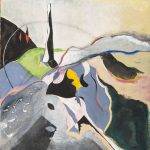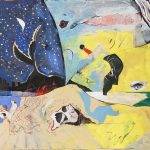SILENT OPERA
For the Presentation of the Exhibition in the Foyer of the Tarragona Theatre.
Recitation of the “Sonnet of the Rose Garland” by Federico García Lorca
Amidst the silence, with my hands stained blue, I traced an oval in the air, using my arms as a compass. The oval remained imprinted upon the space. With a single leap, I distanced myself to observe it. The oval revealed the impressive, wounded megalith of Clot del Mèdol, which from its center radiated geometries and transformed the space into a gigantic sundial. An act of gratitude to the land that allowed our Roman ancestors to extract stone to build the city’s monuments, a ritual of the aristocracy of Roman architects, which adorns the lands of Tamarit de Mar. Thamar, an Arabic word meaning palm tree. Thamar, name of Amnon’s sister, the biblical incestuous siblings from Federico García Lorca’s poem “Romancero Gitano”. Tamarit, a palm forest, a palm grove that also gives its name to the estate of Amèlia, the poet’s cousin, a central character in one of his unfinished works, near the Huerta de San Vicente in the Vega del Guadalquivir, in the lands of Granada.
The painted landscape differs from the real landscape, yet it retains its inherent features and character. The golden hue of the stone, and the lush green of the plant world, this favorite color that Lorca openly associates with eroticism, and which symbolically can signify both life and death. Pure poetry. Green and reddish ochre like the colors of western Cuba that had so fascinated the poet. El Mèdol, a space created by human hand, so close to Lorca’s “Teatro bajo la arena”.
The account that Lluis de Salvador left us of Lorca’s visit to Clot del Mèdol in 1935, following the advice, almost the imposition, of the musician and composer D. Manuel de Falla, is exquisite, not only for qualifying it as a unique setting, but also because, while speaking of architecture, the poet refers to the extreme beauty of the cypresses. Possibly Falla knew El Mèdol, because at the beginning of the 20th century, it hosted the mythical “Concerts Natura”, which granted it the designation of Natural Stage of Catalonia-
The visual percussion of the rain on the garlands commemorating the 80th anniversary of the poet’s visit to Tarragona recalls the sound of the final applause from a devoted and emotional audience, rain that already blessed us when we presented the book “Lorca, the unknown visit” (Work in progress) and now materializes in an oval puddle, the initial form of the scenic space, where some petals float, and a white glove like a water lily, skin of the skin, which shows us an enigmatic key, “Silent Opera”, which, with the exhibition of some of the preliminary studies for the triptych, gives title to the exhibition. Silent Opera, in which emotion intensifies in the silence of the painting. Silence, so precious in current times, invaded by constant noise, which does not allow us to hear the distant voice of the stars, nor that of the approaching jungle.
Just a few meters from where we are now, stood the Teatre Modern, where Lorca premiered his works, with Margarida Xirgu as the figurehead of his ship and where Lluis de Salvador interviewed the poet. And returning to the “Concerts Natura” at El Mèdol, there was never a final concert, because on the day it was scheduled, it rained heavily and they were forced to suspend it. A week later, it was celebrated with full honors, here, at the old Tarragona Theatre, which occupied this very space until not many years ago.
This inaugural event raises the curtain on the commemorative events of the eightieth anniversary of Lorca’s visit to Tarragona: “LORCATS TGN 80”. And this triptych, which I titled “A beach for you”, remains as the memorial of a wish. The poet, in the interview that Lluis de Salvador conducted with him, said that he wanted to build a house by the Mediterranean; that is why I painted a beach for him, which is now a beach for all who, like Lorca, embrace uncertainty as a poetic ingredient.
——————-Josep Maria Rosselló———————–
LORCAN TRAGICOMEDY FILLED WITH MYSTERY
in four interruptions of a slumber
DIDASCALIA
A blink of an eye.
Like a blink of an eye.
In a blink of an eye.
The scene lights up as the eyes open.
The spectator’s eyes as a window inward.
The spectator’s eyes open as the scene lights up.
The action unfolds in a blink of an eye.
Fleeting as a dream.
The scene darkens as the eyes close.
Opening and closing the eyes.
As many times as necessary.
Following the Author’s instructions.
DRAMATIS PERSONAE
Margarida Xirgu
The Journalist
The Poet; subsequently, the Harlequin, the Sailor, the Rugby Player, the Clown, the Prestidigitator,
the Professor of Economics and the Athlete
The Anonymous Citizen
Antoñito el Camborio
Ignacio Sánchez Mejías
A republican hand
Two members of the Benemérita
A Bull; subsequently, the Minotaur
A group of Big-Heads
Salvador Dalí
Luis Buñuel
FIRST EYE-BLINK
CYPRESSES
The eyes open.
The scene is occupied by a cypress forest.
Xirgu peeks out from among the green of a cypress. She smiles at the audience. She hides.
The Journalist peeks out from among the green of another cypress. He is about to speak but is seized by a
coughing fit that he cannot stop. He hides.
An Anonymous Citizen peeks out from among the green of a third cypress. He roars like the lion of
Metro-Goldwyn-Mayer. He ends the roar by showing his teeth, malevolently. He hides.
The Poet appears from one of the sides. He has the sensation that someone is pursuing him. He walks
quickly. He avoids colliding with the trees and turns his head back to check if they are still
following him. Upon reaching the center of the stage, he stops. He searches for something in the pockets
of his trousers.
His eyes, overcome with sleep, close.
SECOND EYE-BLINK
SEPULCHRES
The eyes open with tranquil nonchalance.
The scene is occupied by an expanse of ancient sepulchres. In the background, the iron gates of the
Necropolis.
The Poet appears from one side, leaping over the sepulchres, as if playing
hopscotch.
The slab of one of the sepulchres slides to one side. Through the gap that remains
uncovered, Antoñito el Camborio peeks out.
The slab of a second sepulchre breaks in the middle. One of the fragments falls inside. Through
the free gap, Ignacio Sánchez Mejías peeks out.
The slab of a third sepulchre shifts a few centimeters. A hand emerges from it, raising
a republican flag.
At this moment, the back door bursts open and the black shadows appear
of two members of the Benemérita.
The eyes close quickly.
THIRD EYE-BLINK
THE BULL
The eyes open with difficulty.
With difficulty, hesitation, and sorrow they remain open.
A monumental bull appears in the middle of the village square.
Details from Goya’s The Third of May 1808 are projected onto the bull’s hide,
which for the moment remains motionless.
The Poet emerges from the orchestra pit and ascends to the stage via a side staircase.
Poet and horned one challenge each other with mere intention.
From every window and balcony overlooking the square emerges a nineteenth-century Big-Head.
A moment of hesitation. The eyes close and open repeatedly, as if unwilling to give
credence to what they see.
What they see is the Minotaur who, with a blow to the nape, exhaling snorts laden with clouds
of magenta, makes the Poet flutter, who, with each charge, transforms into Harlequin,
Sailor, Rugby Player, Clown, Prestidigitator, Professor of Economics, and Athlete.
The eyes, despite everything, cannot endure the monster’s presence and close.
FOURTH EYE-BLINK
RAZOR
The eyes open wide, as if seized by great astonishment.
There are a few thinned-out cypresses, some stunted. The Moon evades the cypresses.
The Poet, in the same position as in the First Eye-Blink, continues rummaging in the
pockets.
In the background, among the cypresses, two tricorn hats gleam in the moonlight.
Salvador Dalí descends from one of the cypresses. He looks towards the Poet. He waves goodbye and
leaves.
Luis Buñuel descends from a second cypress. Upon reaching the ground, he looks at the Poet, waves goodbye with his
hand and leaves.
The Anonymous Citizen descends from a third cypress. He approaches the Poet, who is still rummaging in his
pockets. He circles around him as if wanting to ascertain something. Once the
circle is closed, he points at him with a finger while looking in the direction of the tricorn hats.
The Poet finally finds what he was looking for. He takes it out and shows it. It is a razor, which catches the
moonlight and stamps it onto his face.
The sound of an execution’s volley rings out.
The eyes show no interest whatsoever in what is happening on stage and close.
———————————————–



